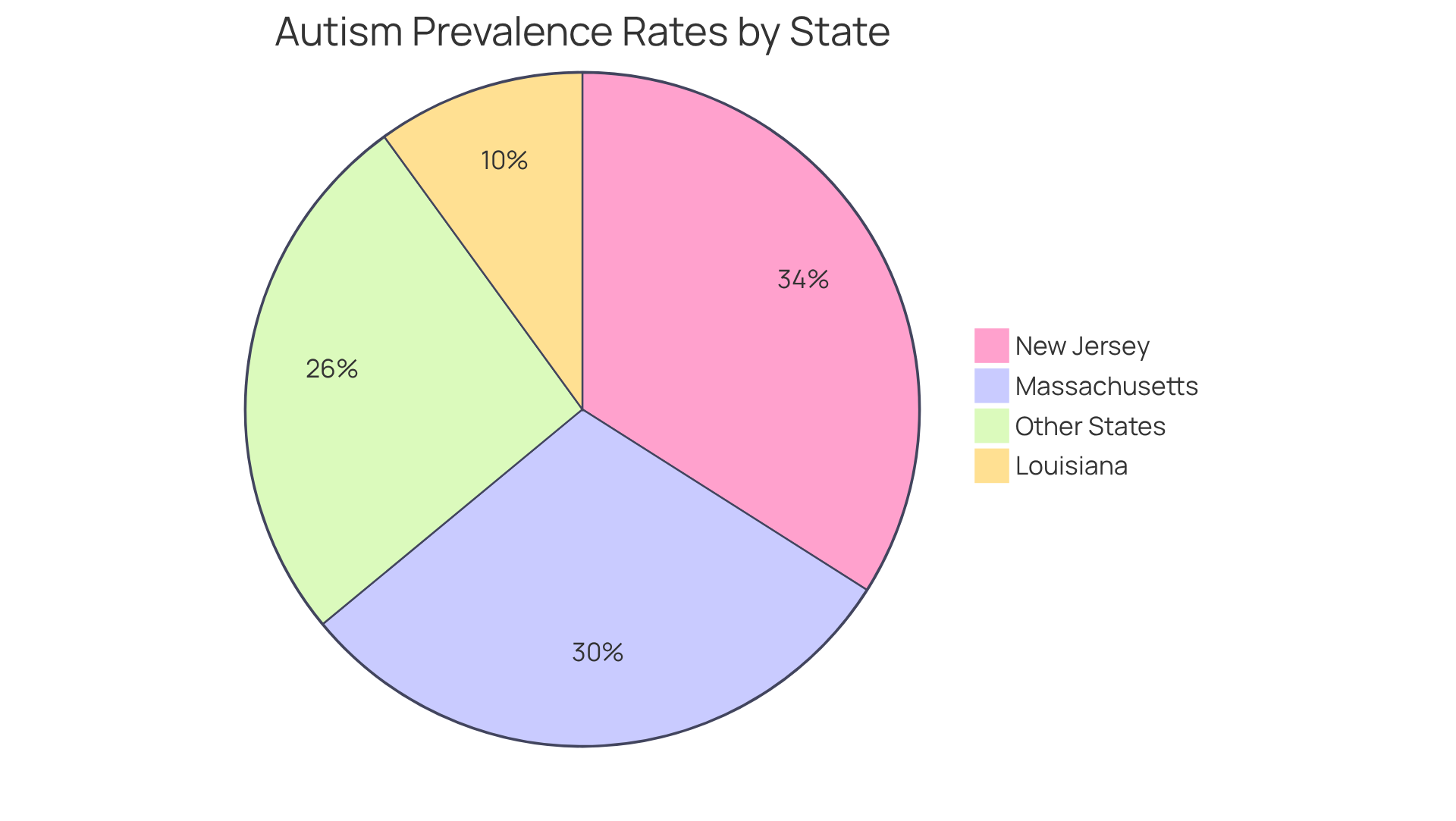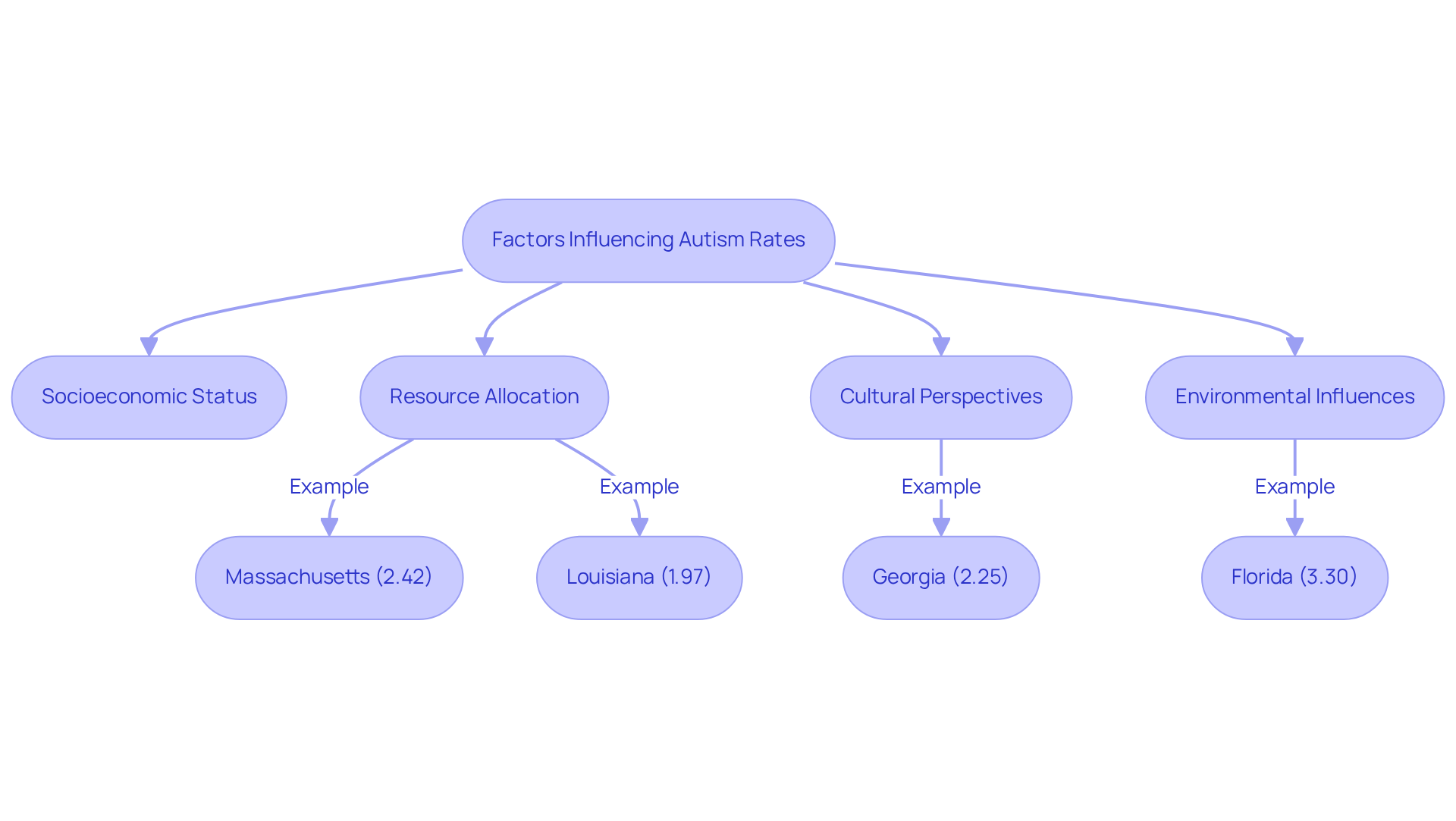Overview
The article highlights the concerning variations in autism rates across different states in the U.S., drawing attention to the significant differences between states like New Jersey and Louisiana. This disparity is largely attributed to better access to diagnostic services and heightened awareness in states with higher prevalence. Conversely, lower rates in some regions often stem from limited resources and underdiagnosis, which can leave many families feeling unsupported.
It's crucial to understand these factors as they deeply impact the lives of those affected by autism. By fostering awareness and advocating for better resources, we can work towards a future where every family receives the support they need.
Introduction
In recent years, the significant increase in autism diagnoses has raised profound concern and curiosity throughout the United States. With approximately 1 in 31 children identified on the spectrum as of 2025, it becomes essential for families and policymakers to grasp the state-by-state variations in autism rates. This article explores the intricate factors that contribute to these disparities, shedding light on the statistics alongside the socioeconomic and environmental influences that shape the landscape of autism support.
How can communities learn from regions with lower prevalence rates to enhance resources and services for families navigating this complex journey? Together, we can foster a deeper understanding and create a supportive environment for all.
Overview of Autism Rates in the United States
As of 2025, the Centers for Disease Control and Prevention (CDC) indicates that approximately 1 in 31 children in the United States is identified with a spectrum condition, leading to an occurrence figure of around 3.2% among children aged 8 years. This marks a significant increase from previous years, reflecting a consistent rise in developmental disorder occurrences across the nation.
Walter Zahorodny, an Associate Professor of Pediatrics at Rutgers New Jersey Medical School, noted, "There's been a very intriguing, hardly recognized and not comprehended change in the demographic profile of this condition." This observation sheds light on the variations in autism rates by state among different regions. For instance:
- New Jersey and Massachusetts are among the states with notably higher autism rates by state,
- while states like Louisiana show lower prevalence figures.
Moreover, the CDC reveals that 39.6% of children with developmental disorders also face co-occurring intellectual disabilities, underscoring the complex needs within this population. Understanding these statistics is vital, as they directly impact the distribution of resources and the development of support systems for families affected by these conditions.
The ongoing rise in developmental disorder diagnoses emphasizes the urgent need for enhanced planning and investment in services to meet the increasing demand. Together, we can advocate for better support and resources for our children and families.

Analysis of the State with the Highest Autism Rate
According to autism rates by state, New Jersey holds the distinction of having the highest prevalence of autism in the United States, with around 1 in 34 children diagnosed with Autism Spectrum Disorder (ASD). This statistic regarding autism rates by state is nearly double the national average, which can be concerning for many families. Factors contributing to the increased autism rates by state may include heightened awareness and better access to diagnostic services, enabling earlier identification of more children.
Additionally, New Jersey boasts robust support systems for individuals on the spectrum. Specialized educational programs and comprehensive healthcare services not only assist families but may also lead to higher reporting figures. The region's commitment to early intervention and extensive care highlights a proactive approach to addressing developmental disorders. This dedication serves as a potential model for other regions, showcasing the importance of community support and resources for families affected by autism.
If you're a parent or caregiver, knowing these facts can feel overwhelming. However, understanding the landscape can empower you to seek the right support and resources for your child. Let’s continue this conversation—share your experiences or questions in the comments, and together we can foster a supportive community.
Factors Influencing Regional Variations in Autism Rates
Understanding the regional differences in autism rates by state across the United States can be quite enlightening, especially for families navigating this journey. Socioeconomic status plays a significant role in these disparities. For instance, more affluent areas like Massachusetts, which reflect autism rates by state at 2.42%, are able to dedicate substantial resources to autism services, which in turn leads to higher identification rates. On the other hand, families in regions such as Louisiana, which has autism rates by state around 1.97%, often encounter challenges stemming from limited access to diagnostic services and educational resources.
Consider states like Florida, which has an autism rate by state of 3.30%, and Georgia, which has an autism rate by state of 2.25%. These figures further illustrate the stark differences in resource allocation and public awareness. It's important to recognize that cultural perspectives on developmental disorders, alongside varying degrees of public awareness, significantly influence how families approach diagnosis and support. Increased awareness often correlates with higher identification rates, highlighting the necessity for ongoing education and advocacy.
Moreover, we cannot overlook environmental influences, such as exposure to pollutants and maternal health issues, which add layers of complexity to our understanding of developmental disorders. As we look ahead to 2025, these dynamics will undoubtedly continue to shape the landscape of diagnosis and support for developmental disorders across different regions. It's crucial for families to stay informed and connected, as the journey can be challenging, but support is available.

Comparison with States Having Lower Autism Rates
Regions with reduced occurrences of developmental disorders, such as Louisiana and Mississippi, highlight a significant contrast to those facing greater prevalence. For instance, Louisiana reports a figure of approximately 1.97%, prompting important questions about the accessibility of diagnostic services and the effectiveness of public health initiatives. Often, these areas have limited resources dedicated to raising awareness and providing interventions, which can result in underdiagnosis. Yet, they may also benefit from community-based approaches that prioritize family support and local engagement.
Understanding the strategies employed in these lower-prevalence states can offer valuable insights for enhancing autism services across the nation. This is especially crucial in regions with higher rates, where families may feel overwhelmed by the complexities of navigating the system. By learning from these experiences, we can foster a more supportive environment for all families, ensuring that they receive the assistance and understanding they truly deserve.
Conclusion
The examination of autism rates across various states reveals a complex and pressing issue that truly demands our attention and action. With approximately 1 in 31 children diagnosed with Autism Spectrum Disorder, understanding the regional variations is crucial for families and policymakers alike. These disparities in autism prevalence are not merely statistics; they reflect the diverse challenges and resources available to families depending on their location.
Key insights from the article highlight that states like New Jersey experience significantly higher autism rates, potentially due to better access to diagnostic services and robust support systems. In contrast, areas such as Louisiana face lower prevalence rates, often indicative of limited resources and awareness. These variations are influenced by factors such as socioeconomic status, public health initiatives, and cultural attitudes towards developmental disorders.
As the landscape of autism diagnoses continues to evolve, it is vital for communities to learn from one another. By sharing successful strategies and fostering awareness, we have an opportunity to enhance resources and support systems for families navigating the complexities of autism. The call to action is clear: let us prioritize advocacy, education, and community engagement to ensure that every child and family affected by autism receives the understanding and assistance they deserve.
Frequently Asked Questions
What is the current autism rate in the United States as of 2025?
As of 2025, approximately 1 in 31 children in the United States is identified with a spectrum condition, which translates to an occurrence rate of around 3.2% among children aged 8 years.
How have autism rates changed over the years?
There has been a significant increase in autism rates over the years, reflecting a consistent rise in developmental disorder occurrences across the nation.
Are there differences in autism rates by state?
Yes, there are variations in autism rates by state. For example, New Jersey and Massachusetts have notably higher autism rates, while states like Louisiana show lower prevalence figures.
What percentage of children with developmental disorders also have intellectual disabilities?
The CDC reveals that 39.6% of children with developmental disorders also face co-occurring intellectual disabilities.
Why is understanding autism statistics important?
Understanding these statistics is vital as they impact the distribution of resources and the development of support systems for families affected by these conditions.
What is the significance of the ongoing rise in developmental disorder diagnoses?
The ongoing rise emphasizes the urgent need for enhanced planning and investment in services to meet the increasing demand for support and resources for affected children and families.




